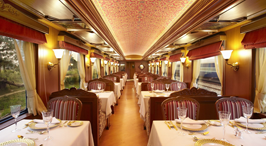Luxury Train
Khajuraho with Maharaja Express

Khajuraho, the temple city of central India, is famous throughout the world for its group of Hindu and Jain Temples having stunning erotic sculptures. These group of monuments, a UNESCO World Heritage site, are thronged by thousands of visitors from across the world to envisage this immortal saga of Hindu art and culture engraved in stone over a thousand years ago. Often referred to as the Kamasutra Temples, Khajuraho is known for its sexually explicit carvings depicting the innocent form of love, a manifestation of stimulated human sentiments.
Spread over an area of 20 square kms, Khajuraho is located about 600 kms south east of New Delhi, in the central Indian state of Madhya Pradesh. Originally 85 temples were built by the Chandela Rajput Kings between the years 950 AD and 1050 AD, but only 22 of them have survived the ravages of time. The local people living in Khajuraho village maintained and kept up the temples as best as they could, but with the passage of time the deep jungles took their toll on the monuments.
In the 19th century the monuments were rediscovered by British army engineer Captain T.S. Burt, followed by General Alexander Cunningham, who explored the site on behalf of the Archaeological Survey of India. In 1986, the Khajuraho Group of Monuments were designated a UNESCO World Heritage Site, and is considered to be one of the "seven wonders" of India.
Khajuraho Group of Monuments
Regarded as one of the finest temple art in the world, Khajuraho Temples showcase not only the creativity of the ancient Indian people, but also the amazing advancement of the rulers under whose patronage and supervision these breathtaking monuments of art were designed and created. These temples, aptly called the symbol of medieval heritage, are divided into three groups – western, eastern and southern – according to their location.
The Western Group is the largest of the three and comprises of some of the most popular temples at Khajuraho. The Western Group is best known, because the largest and most typical temple – The Kandariya Mahadev , dedicated to Lord Shiva – belongs to this group. This temple is perfectly symmetrical and stands 31 meter high. Another important temple in this group is the Chaunsat Yogini, the only granite temple in Khajuraho. This temple has quadrangular plan, and is the earliest surviving shrine of the group dated 900 AD, although only 35 of the original 65 cells remain. Other temples in the Western Group are Devi Jagadambe Temple, Chitragupta Temple, Vishwanath Temple, Nandi Temple, Lakshmana Temple, and the Varaha Temple. Unlike other temples of Khajuraho, the Matangeswara Temple is still a place of worship.
The Eastern Group, lying close to Khajuraho village, comprises of Hindu and Jain temples. The largest Jain temple, Parswanath, falling in this group, is perhaps the finest in this group. The actual image of Parswanath, after which this temple is named, was installed as recently as 1860. The other Jain temple in this group is the Ghantai Temple. North of Parswanath Temple is the more modestly sized Adinatha Temple. The three Hindu temples in the Eastern Group are the Brahma, Vamana and Javari Temples.
The Southern Group of temples lies 5 km from Khajuraho village. The fine Chaturbhuj Temple in this group has a massive intricately carved image of Lord Vishnu in the sanctum. Duladeo Temple, another of the southern group, is a little away from the road to the Jain group of temples.
Mythology
Khajuraho, originally called ‘Kharjuravahaka’, derived its name from the Sanskrit words kharjura meaning date palm and vahaka meaning one who carries. The reason behind the name was perhaps the golden date palms that were grown here.
Legend has it that the Moon God descended on a beautiful maiden Hemavati (daughter of a Brahmin priest) as she bathed in a stream. The child born of this union between a mortal and a god was a son, named Chandravarman, who later founded the Chandela dynasty. Hence, the creators of Khajuraho claimed descent from the moon.
As per belief, harassed by a sensitive society, the unwed mother took refuge in the forests of Central India, where she was a mother as well as a guru to her son. It is believed that Hemavati implored Chandravarman to build temples that would reveal human passions, and in doing so, bring about a realization of the emptiness of human desire. Chandravarman began the construction of the first of the temples, successive rulers added to the fast growing complex.
It is also possible that the Chandelas were followers of the Tantric cult, which believes that gratification of earthly desires is a step towards attaining the infinite liberation of nirvana.
Architecture
The Khajuraho temples are built with sandstone. The builders did not use mortar, and the stones were put together with mortise and tenon joints which were held in place by gravity. The columns and architraves were built with megaliths that weighed up to 20 tons.
Events and Festivals at Khajuraho
The Khajuraho temple complex offers a professional light and sound show every evening, in English and Hindi. This hour long show, conducted in the open lawns of the temple complex, covers the history, philosophy and the art of sculpting of these temples. The story of the magnificient temples is narrated in the majestic voice of Amitabh Bachchan, the greatest star of Bollywood, which gives special effect to the show. Organized by the Government Tourism Department, this show is very entertaining as well as extremely informative.
The most awaited event at Khajuraho is the Khajuraho Dance Festival, held in February / March every year. The dance Festival is an opportunity for visitors to experience various classical Indian dances, with stunning performances of great dancers of India, set against the backdrop of the Chitragupta or Vishwanath Temples.
Local Transport and Shopping
Being a small place, travelling around Khajuraho is quite easy. One can commute within Khajuraho by cycle rickshaws or auto rickshaws, which are safe, convenient and cheap, as well as are readily available. If you are adventurous enough, you can rent a bicycle and ride through the town, as this is the perfect way to visit various temples and monuments at your own pace.
Besides being a favourite destination for tourists, Khajuraho offers excellent shopping opportunities, too. There are many emporiums in Khajuraho from where one can buy replicas of Khajurho’s Temple carvings and other mementos, besides textiles, wood carvings and marble inlay. Books and CDs about the splendid charms of Khajuraho can also be bought for gifting.
Climate
Summers in Khajuraho are extremely hot with temperatures touching 45°C, but the winters are pleasant at 27°C in the day. There is wide variation in day and night temperature. Average rainfall is 114 cms annually, which happens mostly in July and August. The best time to visit Khajuraho is from September to March.
Reaching Khajuraho
Khajuraho is well connected with major Indian cities by Air, Rail and Road. Khajuraho airport, located 5 kms from the city is served by flights from Delhi, Agra, Varanasi and Mumbai. Although Khajuraho has a railway station, nearest railheads are Mahoba and Harpalpur. Jhansi is a convenient railhead for those travelling from Mumbai and Delhi. One can travel from Jhansi, Mahoba or Harpalpur by road, as regular and direct bus service is available from these and other cities to Khajuraho.
Maharaja Express guest always special for us.



